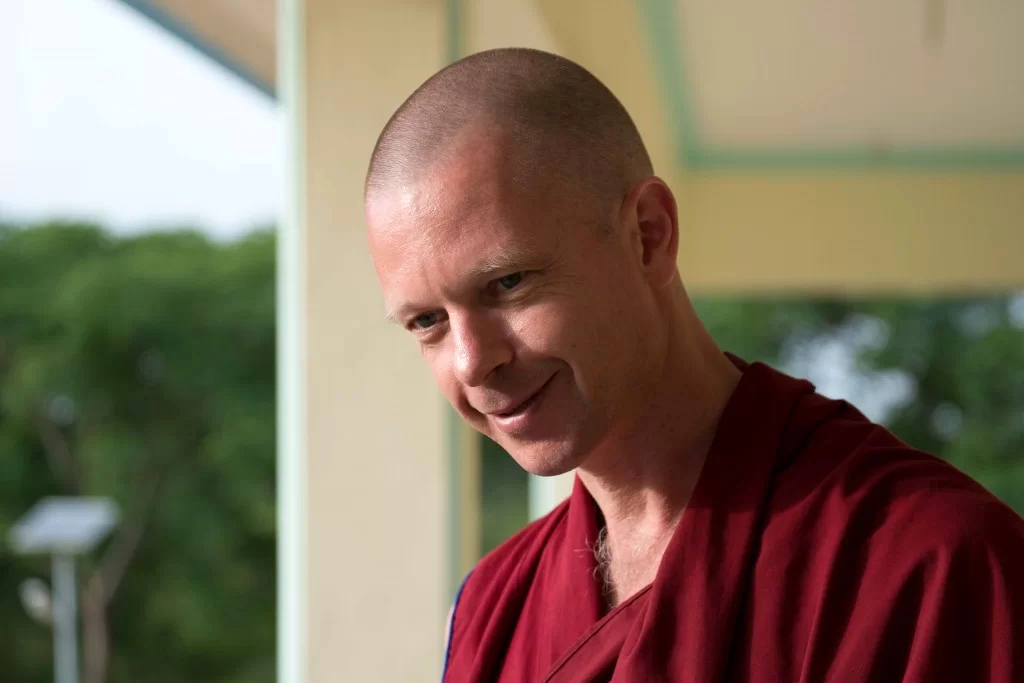
Geshe Tenzin Namdak is no ordinary Buddhist monk. Born and raised in the Netherlands, he had a typically secular Dutch upbringing that included studying for a degree in hydrology at Van Hall Larenstein University before going on to begin a career as an environmental researcher.
In 1993, he began pursuing a growing interest in Buddhism at the Maitreya Institute in Loenen municipality, in the Netherlands. Then in 1995, on the advice of Lama Thubten Zopa Rinpoche, he relocated to Dharamsala in northern India to be ordained and study the Tibetan language. Just one year later, he took full ordination vows from His Holiness the Dalai Lama, before undertaking a traditional formal course of education in Buddhist philosophy and psychology at Sera Jey Monastic University in southern India.
Geshe Namdak became the first Western monastic to complete the full 20-year geshe study program in Tibetan, graduating from Sera Jey Monastic University in April 2016.
Geshe’s academic background in science coupled with a rigorous traditional Buddhist education mean that few people are perhaps better qualified to examine and speak on the intersection and dialogues between contemporary scientific theory and Buddhism’s epistemic philosophical investigation into the nature of the mind and reality.
Geshe Namdak is now the resident teacher at Jamyang Buddhist Centre, London, which is affiliated with the Foundation for the Preservation of the Mahayana Tradition (FPMT). Geshe runs numerous courses and classes on Buddhist philosophy and practice at Jamyang Buddhist Centre, in addition to teaching and speaking engagements around the world.
BDG: Hello Geshe Namdak! It’s a privilege to meet you. Thank you for sharing your time for this interview. To begin, for the benefit of our readers, would you mind talking a little about your personal introduction to Buddhism and the spiritual journey that has brought you to where you are today?
Geshe Tenzin Namdak: Well, I was a university student in the Netherlands, studying hydrology, and much like any other university student, you know, I was trying to enjoy life, going to parties and all of that sort of thing! And then in my early 20s, building on my background in the martial arts, I began to lose interest in the party aspect of life and started to become a little bit more spiritual, you might say, and began to study Chinese medicine on the weekends.
I went from studying martial arts to focusing more on the philosophy behind it, and that in turn led to a growing interest in spirituality. During this period, I started reading about Buddhism and I visited a local Buddhist center, where I met the teacher. And this one weekend more or less changed my whole outlook in the sense that I was able to engage with all these questions I had about life: What’s the meaning of life? Are there past and future lives? Why do some people suffer more than others? Those kinds of fundamental questions. Not that all my questions were answered straight away, of course, but I could see that, at least for me, Buddhist thought has much to offer in terms of addressing those questions.
From there, I began attending more teachings, in particular in the Tibetan Buddhist tradition. Even within those first few months, I quickly started thinking about becoming a monk, but my teacher told me: “Take your time; relax—don’t go too fast! Stay for a year here at the center and study well.”
I had a commitment to the government of the Netherlands to carry out environmental research, which I did during the week. My evenings and weekends I spent at the Dharma center, where I continued to study Buddhism. From there I decided to take a more traditional path by studying the Tibetan language in Dharamsala, and then I entered Sera Jey Monastic University, where I spent a little over 20 years in traditional monastic education.
BDG: So you went from a secular Western upbringing to undergoing a very traditional education in the Tibetan Buddhist tradition. What insights has this offered you into Buddhism—particularly the Vajrayana path—as viewed from a Western perspective? Can you share any observations about tantric Buddhism as it has manifested and is practiced in the West?
GTN: Well, I came here to London directly from India after I finished my education about two years ago. The education within the Tibetan Buddhist tradition is based on the Nalanda tradition, which is extremely rich and in-depth—it takes about two decades to complete, studying throughout in the Tibetan language. And so at Sera Jey Monastic University I graduated with a geshe degree after about 20 years. Then I went on to Gyume Tantric College, which is kind of a traditional way to continue Vajrayana studies for another year. And after that I came to London.
In terms of Vajrayana in the West, there are quite a lot of misunderstandings, as you know, and this is probably basically due to a lack of proper education. The Vajrayana is founded on a strong fundamental understanding of the Sutrayana, the sutra path—in particular lamrim, the stages of the path to enlightenment. But without this fundamental understanding, the tantra or the Vajrayana doesn’t make any sense. This means that the student needs to be well grounded in the lamrim, and in particular bodhicitta and emptiness. Without those two fundamental building blocks, then the Vajrayana won’t make any sense and any attempts at practicing won’t really produce any results.
For some aspirants, the Vajrayana all sounds very exciting, to talk about Mahamudra and Dzogchen and so on. But if the person isn’t properly prepared and grounded, then they’re not really a suitable vessel for these kinds of teachings. But if one is properly prepared, then of course it can offer incredible benefits and incredibly sophisticated practices.
Nowadays, there are a wide variety of people in the West—those with a proper education and those who don’t have that education. Luckily, within the different organizations of the Buddhist doctrine—and that’s not only the Tibetan tradition, but also in the Theravada and other schools and traditions of Buddhism—people can access proper, systematic ways of studying. For example, the organization that I’m a part of, FPMT. They have various programs: two years, three years, five years, and so on. Because Buddhism is still very new in the West, these programs are very, very important because they offer a very good foundational understanding.
We can see within all religions that a very superficial understanding of the teachings can cause all sorts of problems. Misunderstandings lead to conflicts—within oneself and in relation to others. So education is very, very important. His Holiness the Dalai Lama so often emphasizes this importance throughout all forms of faith or religion, and of course in particular within Buddhism: education is essential to prevent misunderstandings in one’s own personal practice and also in relation to all forms of spirituality.
BDG: What would you say to Western lay practitioners who aspire to practice while trying to balance family, work, and other commitments of modern secular life?
GTN: Well, of course there are possibilities even for the busiest people, but this has to come from oneself; we must have the interest and the motivation to dedicate the time. Within the various courses offered not only by the Jamyang Centre but many other Dharma centers, there’s a wide variety of content with choices that depend on how deep we might want to go.
Another important aspect is taking some time to analyze the mind; to be aware if what’s going on inside the mind. This can be achieved with not too much time: in the early morning, for example, and then by trying to be mindful throughout the day. It’s very important that we invest at least a little time and effort toward this.
Quite often, people feel inspired to do something, and perhaps they feel enthusiastic and practice for a few weeks before eventually putting it aside. Then they might come back again for a few weeks. Instead of this kind of fragmented approach, we need to cultivate a constant practice based on a structure within whatever tradition is suitable for the individual—that also needs to be examined—and then we need to put in some effort on a daily basis, returning to it throughout our day. Even if one can only take a few moments to be just a little bit aware, every hour or so, by taking a few minutes for some mindful breathing, being aware of what’s going on in the mind and of the intentions behind your actions, then just doing this becomes a practice.
We can’t all live like great yogis in a cave, so we have to be realistic and see what we can do. But if we can exercise just a little discipline, for sure there will be benefits. I’ve seen many people change—people who have jobs, family lives, commitments—but over time. It takes time to change; it’s not instant, but yes, I’ve seen people change. It’s simply a matter of putting in consistent effort and, throughout the day, working with and dealing with the emotions and other difficulties we may be facing.
In general, I think people in the West can tend to be a little bit shortsighted, to be honest, and a little bit uptight. I see people who enter Buddhism with a certain mindset of “I want to do this, I want to do that.” So I think it’s very important to have a “vast vision” based on the advice of our ancient tradition. It’s a threefold advice that I think is very important for Western practitioners.
To have a vast vision in the Buddhist context, we think of liberation and enlightenment. This is going to take a long time, of course, so you don’t have to rush into things if you have vast vision. Until then, you make plans according to what’s possible for you—you have to be realistic, you have your family life, your work, and so on. So whenever you have some time, try to dedicate that time to do some reading, some contemplation. You can make plans for yourself or you can engage with a study program. There’s so much available now, especially with the hybrid kind of system of either joining a community locally or finding one online. There are incredible opportunities. So you make a plan for yourself with vast vision, then you act on that plan.
Then the third piece of advice, we can say, is to relax. Don’t squeeze yourself. This means that if your mind is relaxed and if you can keep your mind relaxed, you can do so much more. It’s especially important in our fast-energy society to take time off to relax the mind. Many people, it seems, think that life is easier these days because everything is so organized and available, but then people have become so busy and preoccupied with other distractions, such as entertainment and social media, and so on. So it’s very important to take time for oneself. If you only allow yourself to be influenced by external factors, then you’ll never find any peace of mind. You have to take the time to do some awareness building and then, based on that building awareness, follow a few courses on how to change the mind. Then I think you’ll find that things will flow much better in life.
BDG: Quite a lot has been said about the need for reform in monastic education—in terms of preparing lamas and monks in traditional education to engage with and teach people in modern societies, while at the same time preserving the authenticity and profound depth of the Buddhadharma. Based on your own experience, how do you view the future in this regard?
GTN: Oh yes, indeed. His Holiness the Dalai Lama is particularly skillful in the area of monastic institutions, and leading them through more universal and secular aspects of study. This is why there has been a lot of development in scientific studies within the monastic system, and also languages, which was never really present before. This means that the monks and nuns are now far more capable of communicating with practitioners in the Western world—in terms of language and in finding a common ground of culture and science. So that’s definitely bringing great benefits in the near future.
Another aspect that I find very skillful of His Holiness is that the Dalai Lama divides Buddhism into secular or universal aspects and the traditional practices of Buddhism. When we talk about the threefold division of Buddhist studies, we talk about Buddhist mind sciences and psychology as one aspect, and then Buddhist philosophy as another aspect, and Buddhist practice as a third aspect. This means that we can keep the authentic aspects of Buddhist practice very clear. They can be presented and studied as part of the various programs we touched upon earlier. But then to communicate with modern society, from the point of view of mind sciences and philosophy, we can have a very secular and universal presentation of Buddhist principals, without necessarily calling it “Buddhism,” to help Western society deal with mental issues, for example.
But it’s very important to keep things clear. And that’s what I always try to do in whatever talks and teachings I give—recognizing that this is a secular, universal aspect, or that is a Buddhist practice issue. In this way we can keep the authentic teachings of the Buddha pure, yet still use certain aspects in a secular context.
And this is also why here at Jamyang we have started quite recently, about a year ago, an initiative called Science & Wisdom LIVE—a project of dialogues with eminent scientists to build bridges and find common ground with science in areas such as Buddhist philosophy and psychology, because as we know the Western world is very much based on scientific education. We have found a great deal of common ground between the mind sciences and the ultimate nature of reality, for example. And that builds a kind of bridge; we can learn from each other. We learn from scientists and they, in turn, can learn from Buddhism.
Later on, this can translate onto a larger platform, something we can already see happening in certain universities in the US. Things like compassion training and these kinds of programs are being developed with universities and the academic world. This can lead to greater benefits for general society, rather than just being presented within the framework of Buddhism. But again, it’s important to maintain that clarity on which are the secular aspects and which are the traditional parts, because it’s essential to preserve that rich authentic tradition for future generations.
BDG: You mentioned the growing dialogue at the intersection between Buddhism and modern sciences. How do you view the future evolution of this dialogue—in particular with regard to our understanding of the nature of reality, of interconnectedness, and the relationship between consciousness and the material world?
GTN: We’ve already had a number of very interesting dialogues with people such as Prof. Carlo Rovelli, for example, one of the world’s leading writers on quantum mechanics and a very open-minded personality. We’ve had very interesting discussions about the ultimate nature of reality from the perspective of quantum mechanics and in terms of Buddhist philosophy and Nagarjuna’s view of interdependence. There’s a great deal of correlation. In the end, Prof. Rovelli said that he could totally agree with this form of Buddhist philosophy, which fits perfectly within the view of modern quantum mechanics. It’s extremely interesting! In latest book, Helgoland [Penguin Books 2020], Prof. Rovelli has included a chapter on the philosophical aspects of this view of reality that references Nagarjuna, one of the great masters of the Nalanda tradition.
More recently, I’ve conducted a dialogue with Dr. Pim Van Lommel, a well-respected Dutch cardiologist and a researcher in the field of near-death experience (NDE) studies. His research and perspective on near-death experiences are the most scientific we’ve seen to date.
And later this year, we’ll be sharing dialogues with neuroscientists on the nature of consciousness and the brain, and the relationship between the two. As Buddhism teaches, and modern neuroscience seems to agree, consciousness is not merely a function of the brain and so perhaps we have to view it as something separate. And then we have to consider what is the correlation between the two. It’s an extremely rich and interesting field to explore.
We’ve seen a lot of interest in this area. At the moment, we see quite a number of organizations conducting these kinds of dialogues, which is interesting, yet that’s usually as far as it goes. What we’re seeking to do now is to see whether, building on top of this dialogue, we can develop and offer some ongoing educational courses in these areas. In this way, audiences and students will be able to dig a little bit deeper into the material, and hopefully education in this field can be nurtured and grow a bit further.
BDG: Geshe Namdak, thank you again for your time. It’s been a pleasure speaking with you.
See more
Jamyang Buddhist Centre London
Science & Wisdom LIVE
FPMT
Related features from BDG
Science, Technology, Consciousness, and Karma
Further Reflections on Technology and the Buddhist Teachings
Why Spirituality (Sometimes) Fails
UX for Buddhists
Related news from BDG
Science and Wisdom LIVE, Jamyang London Buddhist Centre Plan Buddhism and Quantum Physics e-Learning Course
UPDATE: 84000 Launches New App, with Insights from Dzongsar Khyentse Rinpoche
Illuminating the Mind: New Online Course to Explore the Nature of Mind and Consciousness


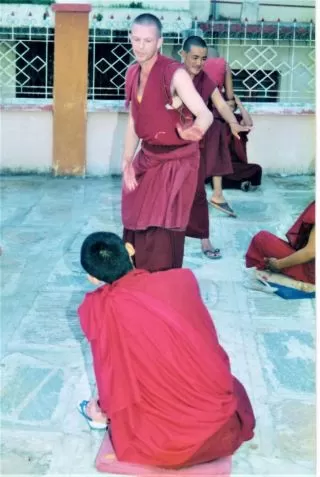



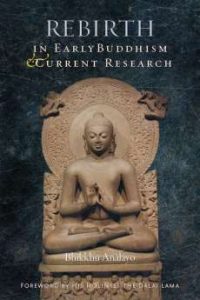

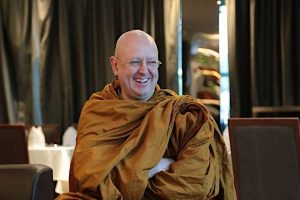
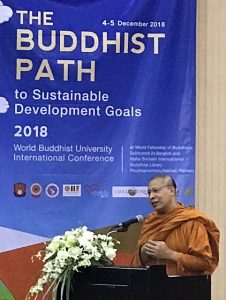
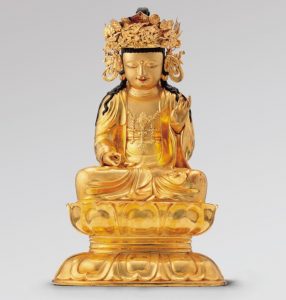



consciousness is about knowing.
enlightement is about knowing everything.
the other shore.